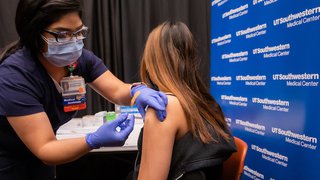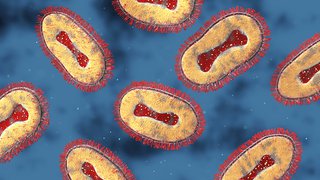
Football fans have always gone to great lengths to support their teams – especially in Texas. Whether it’s cheering on high school squads under Friday night lights, tailgating on Saturdays for college game days, or spending Sundays rooting on America’s Team, the Dallas Cowboys, fall weekends are devoted to football fandom.
The Season of COVID-19, however, is forcing football fanatics to call an audible.
Some teams have postponed their seasons entirely, others have taken the field with no fans in the stands, and a few are trying to strike a delicate balance between allowing spectators and enforcing safety protocols to reduce the risk of spreading the novel coronavirus.
The Cowboys play their home opener Sunday at AT&T Stadium in Arlington and about 20,000 fans (25% of stadium capacity) are expected to attend in person. Dallas is one of a few teams in the NFL starting the season with fans. The Cowboys have announced extensive safety measures, including mandatory masks, digital-only tickets, cohort seating, and empty parking spaces between tailgaters.
But there is no playbook for a being a football fan during a pandemic. So, let’s huddle up and look at your options and risk levels if you plan to attend football games this fall.


Low-to-moderate risks on game day
Outdoor stadiums with small crowds
The good news is that evidence suggests the risk of transmitting COVID-19 outdoors is significantly lower than indoors. Fresh air provides natural circulation, and our respiratory droplets evaporate more quickly outdoors than they do indoors, where air is filtered through an HVAC system and recirculated.
The majority of high school football games are played outdoors at fields where you can sit or stand with six feet of space between you and others. You can also move about easily to open spaces.
Safety tips: Even though the game is outside, every fan should wear a mask that completely covers their nose and mouth. Masks can help contain respiratory droplets, particularly if fans are yelling or cheering. You should also maintain social distance and carry hand sanitizer because it might be difficult to avoid high-touch areas and resist the urge to high-five. (Make a fun sign instead!)

Moderate risks on game day
Tailgating parties

For some fans, the joy of grilling burgers and brats in the parking lot is more fun than the game itself. But there are some reasons to rethink traditional tailgating. It’s a communal experience, where people gather in close proximity for an extended period of time, usually eating and drinking. That makes it difficult to wear your mask consistently – and research has shown masks are among the most effective ways to reduce spreading the virus. In fact, the director of the Centers for Disease Control and Prevention (CDC) told Congress recently that masks are the “most important, powerful public health tool” we have in the fight against COVID-19.
Safety tips: If you’re going to tailgate, set some ground rules. For instance, AT&T Stadium on Sunday will require an empty parking space between tailgates. Many area college stadiums will, too. We’d suggest limiting the number of people in your party to less than five. Also, bring individual condiments and utensils so people don’t have to share. And throw a flag on anyone who won’t wear a mask when they’re not eating or drinking. Tell them the CDC director said so, and he is like a referee during this pandemic.

Outdoor/indoor stadiums with larger crowds
While being outdoors provides some benefit, it doesn’t diminish the risk of spending extended time with a large group of people you don’t know. As the CDC puts it, “when you see more faces, and linger in places,” your risk increases. Texas currently allows stadiums to operate at 50% capacity, but most have announced they will start the season at 25%, including the Cowboys, the University of Texas, SMU, and TCU. This should provide enough space in the stands, but fans will still likely congregate in concession and common areas.
Safety tips: Stick with your group to reduce exposure and wear a mask at all times, especially when waiting in lines. AT&T Stadium has taken many steps to reduce risks on opening day. These include:
- Selling digital-only tickets in cohorts, or pods of 12, to providing ample space in the stands
- Enforcing mask mandates throughout the stadium
- Cleaning escalators, elevators, countertops, and high-touch surfaces throughout the game
- Serving concessions in sealed containers to reduce handling
- Marking six feet of space between fans waiting in lines
- Monitoring restrooms for crowds during halftime
- Keeping the giant doors on each end of the stadium open; the roof may be open, too.

High-risk situations on game day
Watching football at a sports bar or restaurant

Many football fans crave the comradery of watching games together at a restaurant or sports bar – with plenty of hot wings and cold beer. But a recent study from the CDC suggests that might be a high-risk proposition. The new research showed that adults who contracted COVID-19 were twice as likely to have eaten at a restaurant in the previous two weeks. Texas Gov. Greg Abbott announced on Sept. 17 that restaurants could begin operating at 75% capacity, up from 50%, beginning Sept. 21. Bars remain closed, but many sports bars sell enough food to qualify as restaurants and will be open.
Safety tips: The CDC study did not explicitly state whether it was safer to dine on a patio, but in general there should be less risk in an open-air situation. If people are not wearing masks, however, and are sitting close together for long periods of time – talking, cheering, and yelling – the sports bar experience could be dicey.
Restaurants can make it safer by spacing out tables and ensuring staff and patrons wear masks properly. Sit outside when possible and limit the number at your table. Don’t share ketchup bottles or plates of foods. And when not eating and drinking, everyone should wear a mask snugly over their nose and mouth. The perception that you need to lower your mask to talk is just that: perception. Masks should not affect your ability to breathe or talk clearly – just ask your healthcare workers who have been wearing them for hours at a time for years. Wearing a mask just takes some getting used to, and it’s a small price to pay to keep our football season in full swing.
First down and goal to go
Spending a few hours watching a football game can provide a much-needed escape from the ongoing blitz of COVID-19 pressures. The recent return of NFL, college, and high school games can provide that sense of normalcy we’ve all been craving the last six months.
Of course, the safest place to watch football is at home on your television. If you have zero tolerance for risk or you have pre-existing conditions that make you more susceptible to severe COVID-19 complications, that should be your game plan.
If you go to a game in person, it’s going to take a team effort to keep people safe – everyone should work together to follow the protocols that we know reduce the risk for everyone.
And if you find yourself at a game and sense the situation isn’t safe, channel your inner-Peyton Manning and simply call an audible: “Omaha!” Move to an open space, politely ask your fellow fans to follow the guidelines, or, if that doesn’t work, leave. Football fans often claim to “live and die” with their teams.
There’s no reason to make that saying a reality.
For more information on COVID-19 from UT Southwestern's experts, please visit the MedBlog or for updates on the response and testing facility, please visit utswmed.org/covid-19.











